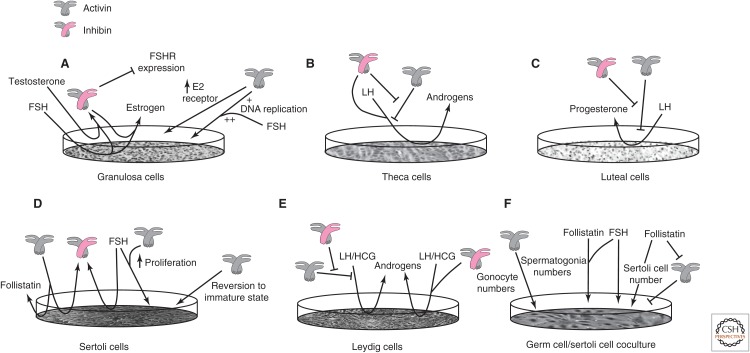Figure 7.
Activin and inhibin effects in cultured gonadal cells. (A) In cultured granulosa cells from early-stage follicles, follicle-stimulating hormone (FSH) stimulates the release of inhibin (gray-pink icon) and estrogen (Hillier et al. 1991a). Inhibin augments FSH-induced estrogen production, while inhibiting the expression of FSH receptor (Campbell and Baird 2001; Lu et al. 2009). In contrast, activin A (gray icon) enhances the expression of estrogen receptors and increases DNA replication, an effect that is augmented by FSH (Rabinovici et al. 1990; Miro and Hillier 1996; Kipp et al. 2007). (B) In cultured theca cells, activin suppresses luteinizing horm (LH)-induced androgen production, while inhibin augments androgen production and antagonizes activin’s suppressive effect (Hillier et al. 1991b). (C) In cultured luteal cells, activin suppresses LH-induced progesterone synthesis, whereas inhibin antagonizes activin’s effects (Rabinovici et al. 1990; Di Simone et al. 1994). (D) Cultured Sertoli cells from young, postnatal rats proliferate in response to FSH and activin A, and FSH increases expression of inhibin. Activin stimulates follistatin and inhibin production and causes adult-derived Sertoli cells to revert to a less differentiated state. (E) LH or human chorionic gonadotropin (HCG) induces androgen production in rodent Leydig cells. Inhibin increases and activin antagonizes LH-induced androgen production and inhibin blocks activin’s suppressive effect. The activin and inhibin effects on androgen production require LH and HCG. (F) When treated with activins, cocultures of germ cells and Sertoli cells from early postnatal rat testis show increased numbers of spermatogonia and gonocyte precursors. The combination of FSH and follistatin also increases the number of spermatogonia. Activin treated co-cultures have fewer Sertoli cells than controls, an effect that is suppressed by follistatin. Follistatin also independently increases the number of Sertoli cells.

